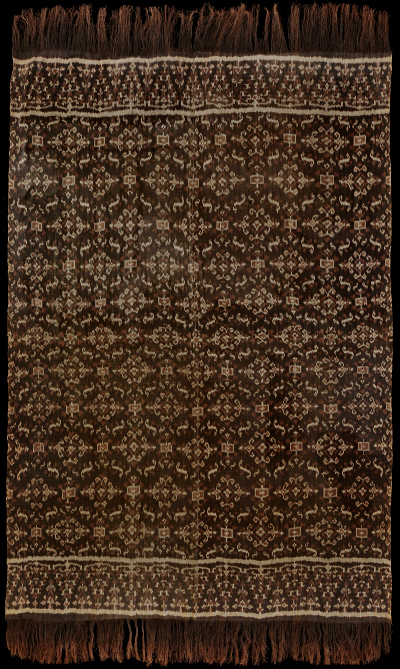| |
 
 | | | |
199 Flores Group, Ende
Semba (man's shawl)  
| | Locale: | � | | Period: | 19th - early 20th c. | | Yarn: | Cotton, hand-spun, fine | | Technique: | Weft ikat | | Panels: | 2 | | Size: | 145 x 213 cm (4' 9" x 6' 11") LW: 1.47 | | Weight: | 840 g (29.6 oz), 272 g/m2 (0.89 oz/ft2) | | Design: | Patola inspired design with jilamprang-like motifs arranged in an array of eleven horizontal and six vertical bands (alternating six whole motifs and five plus two halves). The patterns are executed in ecru (the natural colour of the fibre), two tones of morinda - both brownish but one closer to ochre - and a very dark brown, almost black, the result of overdying indigo with morinda. Elaborate tumpal borders. On one end three bundles of warp thread have been made into plaits. | | Comment: | Late 19th or early 20th C. Ende man's cloth, semba. Large, and of a type suitable for grand ceremonies, also usable as shroud. Exquisite patola-inspired design, with variation of jilamprang-like motif not seen elsewhere, unusually rich in detail. Elaborate tumpal borders. This example still has its original starch, and clearly was never ever washed. Oddly, three bunches of fringe have been braided. While commercial thread came to Ende early, microscopy leaves no doubt that this cloth was done in hand spun. It also reveals very odd weaving: most is done with two warp yarns running in parallel crossed by two weft yarns also use in parallel, but parts with single warp yarns. Occasionally, two pairs of weft yarns are skipped, so that the warp floats across three. In these deviations no pattern could be detected. From old Dutch collection. A few tiny holes, otherwise in very good condition for its age. | | Background: | Chapters on Flores Group and Ende. | | Compare: | 100 161 | | Sources: | Similar to early 20th C. semba in Khan Majlis, Woven Messages, Fig. 157, though somewhat more elaborate. Pattern similar to narrower to that of narrower semba dated around 1910, in Khan Majlis, Indonesische Textilien, Wege zu Goettern und Ahnen, Fig. 374. Overall appearance very similar to semba in Deutsches Textilmuseum in Krefeld, Nr. 15711, depicted in Khan Majlis's appendix to Vö:lger and Von Welkck, Indonesian Textiles, Fig. 137. | | |

©Peter ten Hoopen, 2025
All rights reserved.
|
|


